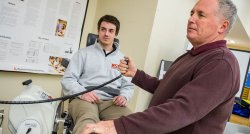To provide students with the means to meet the challenges of the ATP, the faculty and staff are committed to meeting the following goals:
Student Learning Outcomes, Assessments, and Benchmarks/Standards
- Pass the BOC exam on the first attempt
- BOC exam is the assessment and the standard is >70% first time passing for a 3-year period.
- BOC exam is the assessment and the standard is an overall passing rate at or better than the national average.
- Pass the BOC exam on a subsequent attempt
- BOC exam is the assessment and the standard is >70% first time passing for a 3-year period.
- BOC exam is the assessment and the standard is an overall passing rate at or better than the national average.
Point Person and Frequency of Assessment
- The program director/coordinator will serve as the point person for this assessment. The assessment will be conducted annually and the standard will be reviewed annually.
Student Learning Outcomes, Assessments, and Benchmarks/Standards
- Transfer the knowledge learned in class to each clinical experience and demonstrate effective clinical decision making.
- The clinical proficiency assessment (referred to as Form A) is the assessment and the standard is that 80% or more students will meet or exceed the standard for each clinical education class.
- Integrate clinical skills into clinical practice.
- The clinical proficiency assessment (referred to as Form A) is the assessment and the standard is that 80% or more students will meet or exceed the standard for each clinical education class.
- Integrate professional behaviors into clinical practice.
- The professional behavior assessment (referred to as Form B) is the assessment and the standard is that 80% or more students will meet or exceed the standard for each clinical education class.
Point Person and Frequency of Assessment
The course instructor for each clinical education course (ATTR251, ATTR252, ATTR351, ATTR352, and ATTR451) will serve as the point person for the assessment. These assessments are conducted each semester and reviewed annually.
Student Learning Outcomes, Assessments, and Benchmarks/Standards
- Demonstrate competence on skill assessments for each clinical education course.
- Skill competency assessments conducted by course instructors and preceptors for each clinical education course is the assessment and the standard is that an average of 80% or more students will meet or exceed the standard for each clinical education class based on course requirements.
- Engage in the minimum but no more than the maximum hours for each clinical education course.
- Clinical time/attendance sheets submitted by each student is the assessment and the standard is that an average of 80% or more students will meet or exceed the standard for each clinical education class based on course requirements.
Point Person and Frequency of Assessment
The course instructor for each clinical education course (ATTR251, ATTR252, ATTR351, ATTR352, and ATTR451) will serve as the point person for the assessment. These assessments are conducted each semester and reviewed annually.
Student Learning Outcomes, Assessments, and Benchmarks/Standards
- Complete Human Subjects Training
- The senior research project in ATTR 360 will serve as the assessment and the standard is that 80% of students will complete CITI human subjects training.
- Obtain IRB approval for a research protocol
- The senior research project in ATTR 360 will serve as the assessment and the standard is that 80% of students will obtain approval for a research protocol from the IRB.
- Generate a data-based senior project
- The senior research project in ATTR 360 will serve as the assessment and the standard is that 80% of students will produce a refereed submission quality research product from their data (paper, poster, oral presentation).
Point Person and Frequency of Assessment
The course instructor for ATTR 360 will serve as the point person for the assessment. These assessments are conducted and reviewed annually.
Student Learning Outcomes, Assessments, and Benchmarks/Standards
- Participate in in professional development activities
- Students attend/engage in 2 professional activities each academic year. The attendance roster or other documents demonstrating proof of attendance will serve as the assessment.
- Engagement as a student leader
- Students participate in a leadership role during at least one event each academic year. The attendance roster or other documents demonstrating proof of attendance will serve as the assessment.
Point Person and Frequency of Assessment
The course instructor for each clinical education course (ATTR251, ATTR252, ATTR351, ATTR352, and ATTR451) will serve as the point person for the assessment. These assessments are conducted each semester and reviewed annually.
Student Learning Outcomes, Assessments, and Benchmarks/Standards
- Characterize their experiences in the athletic training program as positive and adequate in preparation for their career objectives
- The senior exit survey will serve as the assessment and the standard is that an average of 80% or more will report positive responses.
- Engage in experiences that prepare them for careers or graduate studies after they complete the program.
- The alumni survey will serve as the assessment and the standard is that an average of 80% or more will report positive responses.
Point Person and Frequency of Assessment
The program director/coordinator and CCHL assessment coordinator will serve as the point persons for the assessment and the assessment and the assessments will be conducted and reviewed annually and 6-12 months post-graduation for each cohort.
Student Learning Outcomes, Assessments, and Benchmarks/Standards
- Engage in a minimum of 20 hours of inter-professional clinical education.
- The non-orthopedic clinical experience will serve as the assessment and the standard is that 80% or more students will meet or exceed the requirement.
- Recognize and value inter-professional role of the Athletic Trainer in healthcare.
- The reflection essay on the non-orthopedic clinical experience will serve as the assessment and the standard is that 80% or more students will report the benefit of inter-professional experiences.
Point Person and Frequency of Assessment
The course instructors for ATTR310 and ATTR451 will serve as the point persons for the assessment. These assessments are conducted and reviewed annually.
